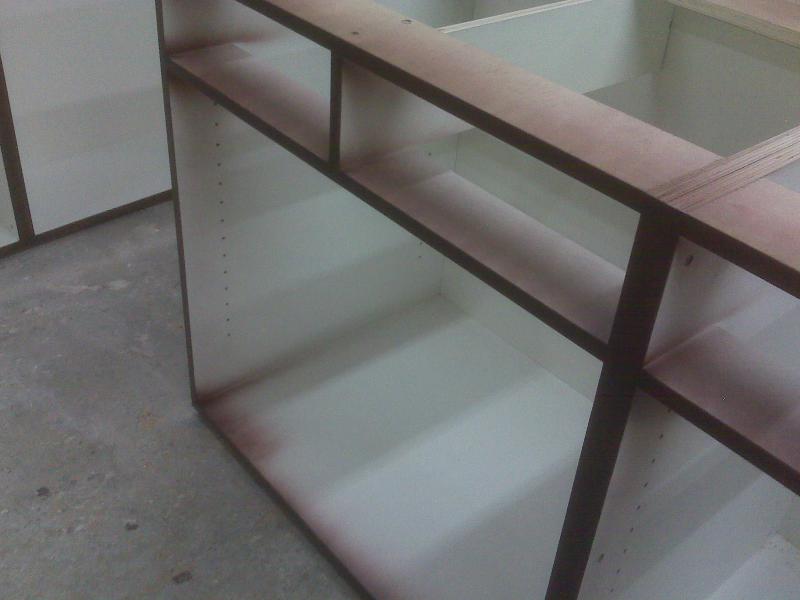Question
I have to stain ten interior raised panel oak doors. I usually brush or rag my stain on, which takes a long time, so I was thinking of spraying it. The stain is oil base Zar fruitwood. I did not want to use my good spray gun, so I was thinking of buying a cheap Harbor Freight gravity HVLP gun.
What would be the best n/n to spray the stain? The spray room in my shop is not a dedicated spray room. I pull a goff curtain to separate my spray area from my shop and I cover the floor with rosin paper. Does spraying oil base stain make a big mess, or can you turn the air down and not atomize the stain?
Forum Responses
(Finishing Forum)
From contributor K:
Normally when shops switch to a spray only coloring system, it is done with a dye and not a normal stain. Normal stain will basically paint the surface and hide the grain. You could spray the stain and then wipe it off as if you applied with a rag or whatever. You will waste more product, but it is faster. Stain cleans up out of guns easily with lacquer thinner, and spraying it with your good gun really won't hurt. You will get more on your floor, but it's not all that bad. Use low pressure to keep from blowing it everywhere.
1) NGR stain is a very fast drying dye stain that can be applied by spray only, no wiping.
2) Vinyl or lacquer based spray stain has pigments added to a vinyl or lacquer base. The vinyl or lacquer base is used as a binder. These are spray only, no wiping.
3) Wiping stain is what you are referring to above, and here is how I do it. Use a cheap junk gun. Very low atomizing pressure so it is doing just a little better than sputtering. Spray the surface, and be sure to get the crack where the panel meets the frame (so you don't end up with a white line due to wood movement). Now take a fairly wet rag and smear the stain around, then wipe away the excess with a clean rag as you would with a wiping stain.
This is just a much faster method of applying the stain than by brush, sponge, or rag. These stains must be wiped off, as they do not contain a binder, and a topcoat finish failure will occur if you do not wipe away the excess. Tip size doesn't really make too much difference, as you don't really care how nice it goes on - you just want to get it on. I think my stain gun has a 1.4 tip. I use very low pressure so hardly any overspray is created.
Your floor will get covered in stain, so it is a good idea to put some paper down if you care about your floor. Be sure to let the paper dry before disposing so you don't end up with spontaneous combustion. Treat the floor paper just as you would your dirty stain rags and dispose with caution. Basically, spray on, smear around, wipe off. It's that simple and is a very fast way to apply a wiping stain.
If I was going to do this job, I would place all the doors against the wall, spray all the face sides, wipe 'em down, flip 'em over, and do the other side. If you have a helper, you can start spraying while your helper starts wiping. Quick/easy, and profitable.
Not so. They certainly do contain a binder. The binder is what combusts spontaneously. And Zar stains certainly do warrant caution, especially with the wiping rags, even more than the floor paper. Dispose of those rags according to code, in closed metal containers that are filled with water. Laying the rags out to dry is not 100%, which is why OSHA and your fire department don't allow it.
Contributor C, your tip for using the bug sprayer to apply stain is excellent. Just excellent. This has to be in the category of why-didn't-I-think-of-that type of excellent.
In the past, I used Zar a lot and my preference was to thin it about 50% with odorless mineral spirits. I used odorless just to keep the smell down; regular mineral spirits will work fine, or you could use naphtha, zylene, toluene, or even lacquer thinner if you prefer. Mineral spirits evaporate slower and gives you more time to wipe large surface like a full size door.
Like other consumer grade wood stains, Zar contains a fair amount of linseed oil (at least it used to), which dries more slowly than the production stains commonly used in finish shops. Once dry, it's pretty tough in the sense that you do need to use lacquer thinner to clean the spray equipment.
The slow dry time can be a concern if you're using a waterborne or catalyzed finish (pre-cat lacquer, conversion varnish, 2K PU, etc.) over it. Many waterborne finishes will not adhere well to drying oils (e.g., linseed or tung) that are not dried well. The same is true for catalyzed finishes. With catalyzed finishes, you can use the proper vinyl sealer over the stain, essentially treating it like an oil-base glaze. For water based finishes, I add an ounce of Japan Drier to each quart of stain before use (or thinning) and then let it dry overnight. In all but the most humid conditions, the stain will be dry the next day and you won't have any problems with the water based finish adhering well. If it is extremely humid, you'll have to give the stain extra time to dry.
